形容词和副词的用法
- 格式:docx
- 大小:23.72 KB
- 文档页数:6
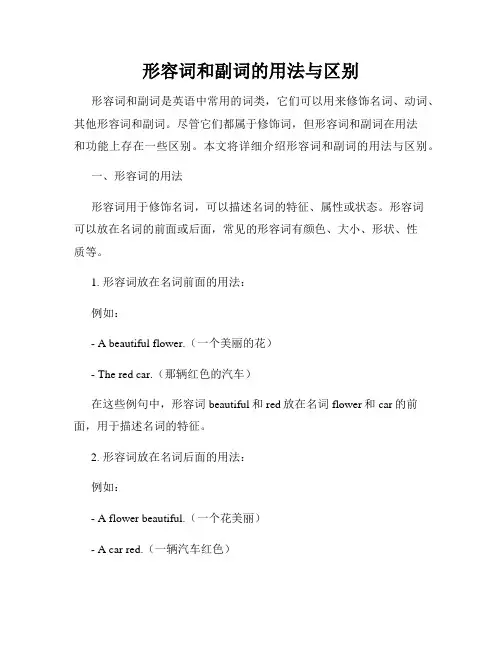
形容词和副词的用法与区别形容词和副词是英语中常用的词类,它们可以用来修饰名词、动词、其他形容词和副词。
尽管它们都属于修饰词,但形容词和副词在用法和功能上存在一些区别。
本文将详细介绍形容词和副词的用法与区别。
一、形容词的用法形容词用于修饰名词,可以描述名词的特征、属性或状态。
形容词可以放在名词的前面或后面,常见的形容词有颜色、大小、形状、性质等。
1. 形容词放在名词前面的用法:例如:- A beautiful flower.(一个美丽的花)- The red car.(那辆红色的汽车)在这些例句中,形容词beautiful和red放在名词flower和car的前面,用于描述名词的特征。
2. 形容词放在名词后面的用法:例如:- A flower beautiful.(一个花美丽)- A car red.(一辆汽车红色)在这些例句中,形容词beautiful和red放在名词flower和car的后面,也用于描述名词的特征。
除了修饰名词外,形容词还可以作为系动词(如be动词)的补语,用于描述主语。
例如:- She is happy.(她很开心)- The box is heavy.(这个盒子很重)二、副词的用法副词用于修饰动词、形容词、其他副词和整个句子,可以表示时间、地点、方式、程度等不同的语义。
副词通常放在动词后面,形容词和副词前面。
1. 修饰动词的副词用法:例如:- She runs quickly.(她跑得很快)- He speaks fluently.(他说得很流利)在这些例句中,副词quickly和fluently修饰动词runs和speaks,表示动作的方式或速度。
2. 修饰形容词的副词用法:例如:- The car is very fast.(这辆车非常快)- He is quite tall.(他相当高)在这些例句中,副词very和quite修饰形容词fast和tall,表示程度或强调。
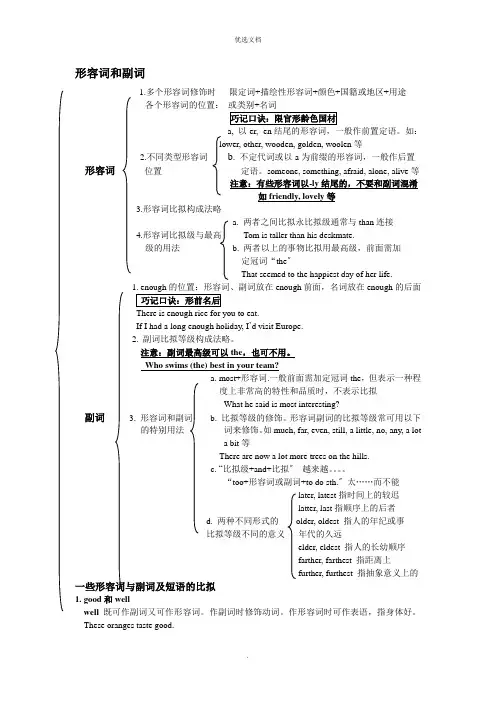
形容词和副词1.多个形容词修饰时限定词+描绘性形容词+颜色+国籍或地区+用途各个形容词的位置:a, 以-er, -en结尾的形容词,一般作前置定语。
如:lower, other, wooden, golden, woolen等2.不同类型形容词 b.不定代词或以-a为前缀的形容词,一般作后置形容词位置定语。
someone, something, afraid, alone, alive等注意:有些形容词以-ly结尾的,不要和副词混淆如friendly, lovely等3.形容词比拟构成法略a. 两者之间比拟永比拟级通常与than连接4.形容词比拟级与最高Tom is taller than his deskmate.级的用法 b. 两者以上的事物比拟用最高级,前面需加定冠词“the〞That seemed to the happiest day of her life.enough前面,名词放在enough的后面There is enough rice for you to eat.If I had a long enough holiday, I’d visit Europe.2. 副词比拟等级构成法略。
注意:副词最高级可以the,也可不用。
Who swims (the) best in your team?a. most+形容词.一般前面需加定冠词the,但表示一种程度上非常高的特性和品质时,不表示比拟What he said is most interesting?副词 3. 形容词和副词 b. 比拟等级的修饰。
形容词副词的比拟等级常可用以下的特别用法词来修饰。
如much, far, even, still, a little, no, any, a lota bit等There are now a lot more trees on the hills.c. “比拟级+and+比拟〞越来越。
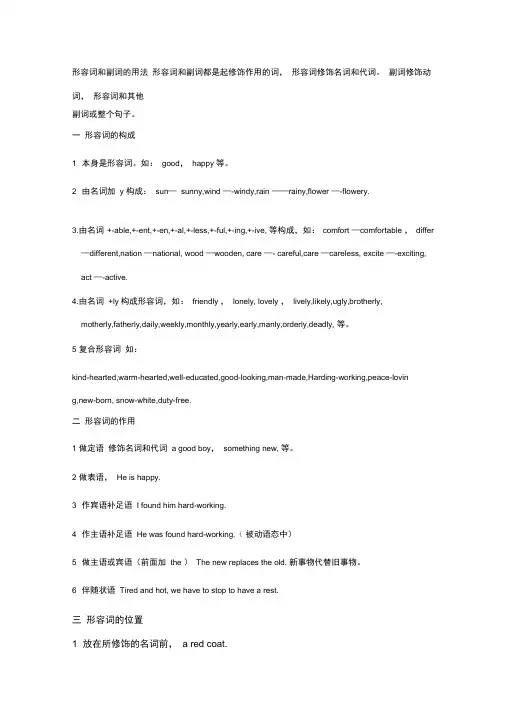
形容词和副词的用法形容词和副词都是起修饰作用的词,形容词修饰名词和代词。
副词修饰动词,形容词和其他副词或整个句子。
一形容词的构成1 本身是形容词。
如:good,happy 等。
2 由名词加y 构成:sun—sunny,wind —-windy,rain ——rainy,flower —-flowery.3.由名词+-able,+-ent,+-en,+-al,+-less,+-ful,+-ing,+-ive, 等构成,如:comfort —comfortable ,differ—different,nation —national, wood —wooden, care —- careful,care —careless, excite —-exciting, act —-active.4.由名词+ly 构成形容词,如:friendly ,lonely, lovely ,lively,likely,ugly,brotherly,motherly,fatherly,daily,weekly,monthly,yearly,early,manly,orderly,deadly, 等。
5 复合形容词如:kind-hearted,warm-hearted,well-educated,good-looking,man-made,Harding-working,peace-loving,new-born, snow-white,duty-free.二形容词的作用1 做定语修饰名词和代词 a good boy,something new, 等。
2 做表语,He is happy.3 作宾语补足语I found him hard-working.4 作主语补足语He was found hard-working.(被动语态中)5 做主语或宾语(前面加the )The new replaces the old. 新事物代替旧事物。
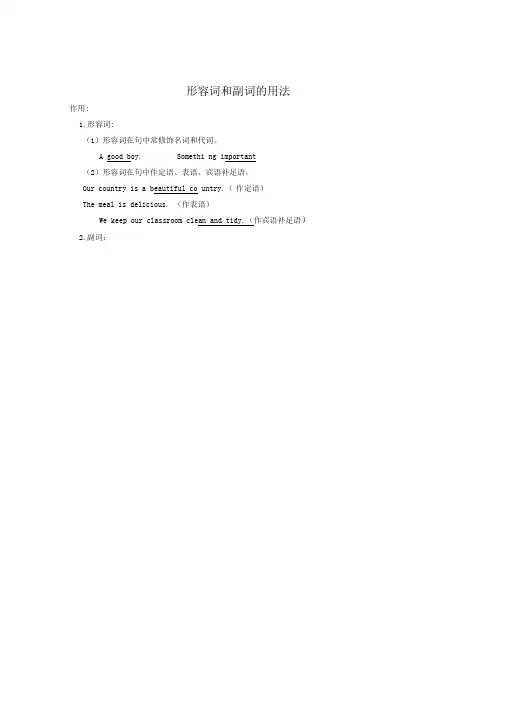
形容词和副词的用法作用:1.形容词:(1)形容词在句中常修饰名词和代词。
A good boy. Somethi ng important(2)形容词在句中作定语、表语、宾语补足语。
Our country is a beautiful co untry.(作定语)The meal is delicious. (作表语)We keep our classroom clean and tidy.(作宾语补足语)2.副词:(1)副词在句中修饰动词、副词、形容词、全句(Luckily)。
She speaks En glish w也(2)副词在句中可作状语、表语、和定语。
He studies very hard. (作状语)When will you be back. (作表语)Luckily, I passed the exam.常用来修饰原级的词有:very , too, so, really, quite, pretty、位置1.形容词:通常要放在所修饰的名词之前,但要放在不定代词(之后。
something、anything …)2.副词:1 )多数副词作状语时放在行为动词之后。
如果动词带宾语,则放在宾语之后。
Mr. Smith works very hard._ She speaks En glishweJl.2)频度副词作状语时,通常放在行为动词之前,情态动词、be动词和助动词之后。
He usually gets up early.3)程度副词一般放在所修饰的名词前面。
I am n ever late for school.He runs very fast.形容词和副词的比较级和最高级。
大多数形容词和副词有三个等级:原级、比较级、最高级。
原级指形容词和副词的原形;比较级用来表示较……”或更……一些”;最高级则表示最……”、形容词和副词的原级:1.表示两者(A与B)在某一方面相同时用句型:A +谓语+ as +形容词或副词的原形+ as+ B.。
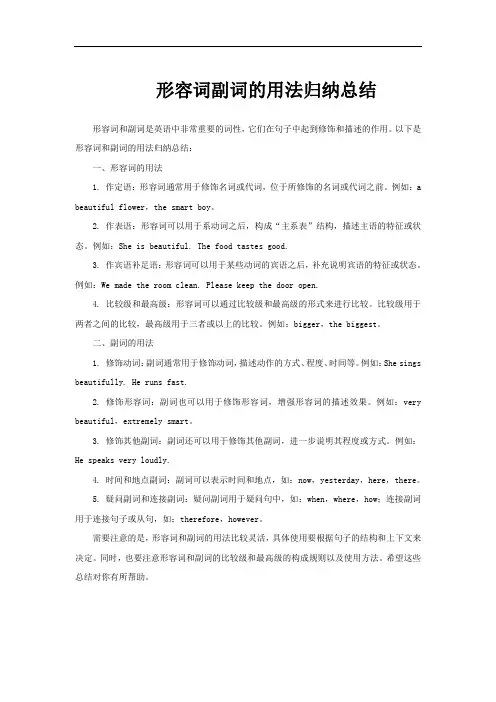
形容词副词的用法归纳总结形容词和副词是英语中非常重要的词性,它们在句子中起到修饰和描述的作用。
以下是形容词和副词的用法归纳总结:一、形容词的用法1. 作定语:形容词通常用于修饰名词或代词,位于所修饰的名词或代词之前。
例如:a beautiful flower,the smart boy。
2. 作表语:形容词可以用于系动词之后,构成“主系表”结构,描述主语的特征或状态。
例如:She is beautiful. The food tastes good.3. 作宾语补足语:形容词可以用于某些动词的宾语之后,补充说明宾语的特征或状态。
例如:We made the room clean. Please keep the door open.4. 比较级和最高级:形容词可以通过比较级和最高级的形式来进行比较。
比较级用于两者之间的比较,最高级用于三者或以上的比较。
例如:bigger,the biggest。
二、副词的用法1. 修饰动词:副词通常用于修饰动词,描述动作的方式、程度、时间等。
例如:She sings beautifully. He runs fast.2. 修饰形容词:副词也可以用于修饰形容词,增强形容词的描述效果。
例如:very beautiful,extremely smart。
3. 修饰其他副词:副词还可以用于修饰其他副词,进一步说明其程度或方式。
例如:He speaks very loudly.4. 时间和地点副词:副词可以表示时间和地点,如:now,yesterday,here,there。
5. 疑问副词和连接副词:疑问副词用于疑问句中,如:when,where,how;连接副词用于连接句子或从句,如:therefore,however。
需要注意的是,形容词和副词的用法比较灵活,具体使用要根据句子的结构和上下文来决定。
同时,也要注意形容词和副词的比较级和最高级的构成规则以及使用方法。
希望这些总结对你有所帮助。
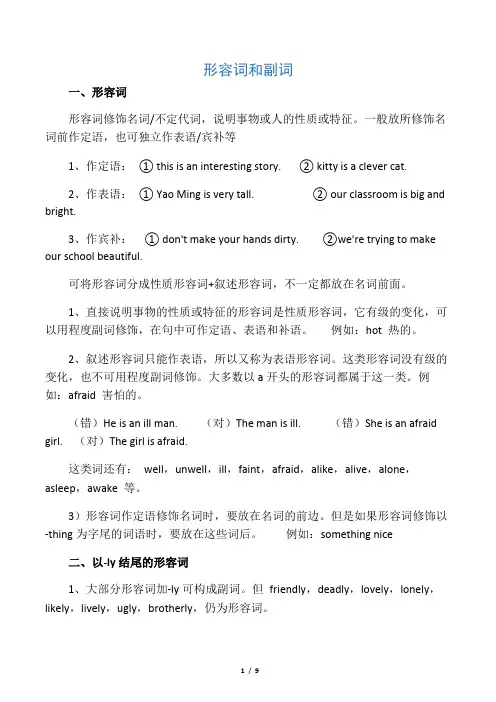
形容词和副词一、形容词形容词修饰名词/不定代词,说明事物或人的性质或特征。
一般放所修饰名词前作定语,也可独立作表语/宾补等1、作定语:① this is an interesting story. ② kitty is a clever cat.2、作表语:① Yao Ming is very tall. ② our classroom is big and bright.3、作宾补:① don't make your hands dirty. ②we're trying to make our school beautiful.可将形容词分成性质形容词+叙述形容词,不一定都放在名词前面。
1、直接说明事物的性质或特征的形容词是性质形容词,它有级的变化,可以用程度副词修饰,在句中可作定语、表语和补语。
例如:hot 热的。
2、叙述形容词只能作表语,所以又称为表语形容词。
这类形容词没有级的变化,也不可用程度副词修饰。
大多数以a开头的形容词都属于这一类。
例如:afraid 害怕的。
(错)He is an ill man. (对)The man is ill. (错)She is an afraid girl. (对)The girl is afraid.这类词还有:well,unwell,ill,faint,afraid,alike,alive,alone,asleep,awake 等。
3)形容词作定语修饰名词时,要放在名词的前边。
但是如果形容词修饰以-thing为字尾的词语时,要放在这些词后。
例如:something nice二、以-ly结尾的形容词1、大部分形容词加-ly可构成副词。
但friendly,deadly,lovely,lonely,likely,lively,ugly,brotherly,仍为形容词。
改错:(错)She sang lovely. (错)He spoke to me very friendly.(对)Her singing was lovely. (对)He spoke to me in a very friendly way.2、有些以-ly 结尾既为形容词,也为副词。
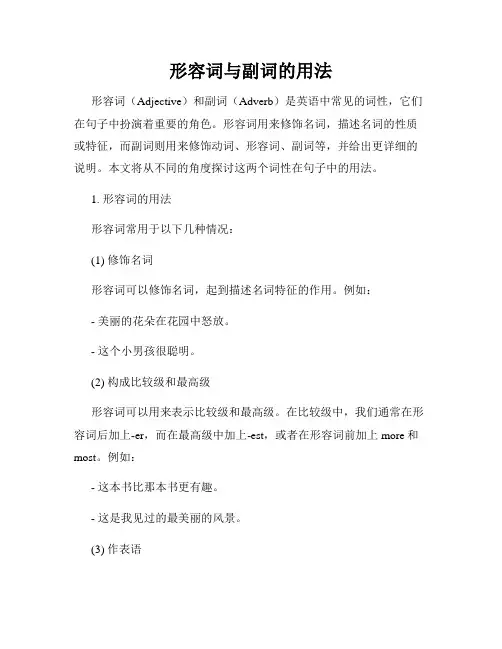
形容词与副词的用法形容词(Adjective)和副词(Adverb)是英语中常见的词性,它们在句子中扮演着重要的角色。
形容词用来修饰名词,描述名词的性质或特征,而副词则用来修饰动词、形容词、副词等,并给出更详细的说明。
本文将从不同的角度探讨这两个词性在句子中的用法。
1. 形容词的用法形容词常用于以下几种情况:(1) 修饰名词形容词可以修饰名词,起到描述名词特征的作用。
例如:- 美丽的花朵在花园中怒放。
- 这个小男孩很聪明。
(2) 构成比较级和最高级形容词可以用来表示比较级和最高级。
在比较级中,我们通常在形容词后加上-er,而在最高级中加上-est,或者在形容词前加上more和most。
例如:- 这本书比那本书更有趣。
- 这是我见过的最美丽的风景。
(3) 作表语形容词可以用作表语,与主语连系动词一起说明主语的特征或状态。
例如:- 这个问题很困难。
- 我很高兴。
2. 副词的用法副词常用于以下几种情况:(1) 修饰动词副词可以修饰动词,表示动作的方式、程度等。
例如:- 他慢慢地走过了街道。
- 她轻轻地打开了门。
(2) 修饰形容词和副词副词也可以修饰形容词和副词,表示程度或者方式。
例如:- 这个女孩非常漂亮。
- 他们跑得很快。
(3) 修饰整个句子副词有时可以修饰整个句子,表示说话人的态度、观点或推测。
例如:- 显然,他是个天才。
- 或许,我们会成功。
总结:形容词和副词在英语句子中的用法多种多样,灵活运用它们可以使句子更加生动、精确。
形容词用来修饰名词,描述名词的性质或特征;而副词则用来修饰动词、形容词、副词等,并给出更详细的说明。
在写作中,我们应该注意正确使用形容词和副词,使句子表达更加准确、丰富。
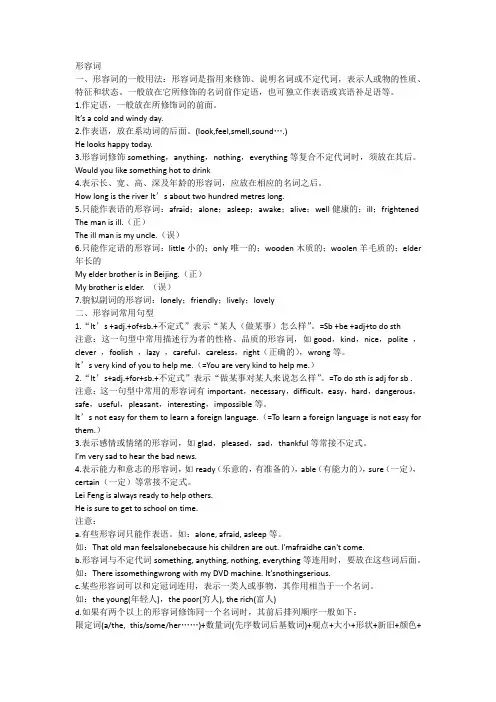
形容词一、形容词的一般用法:形容词是指用来修饰、说明名词或不定代词,表示人或物的性质、特征和状态。
一般放在它所修饰的名词前作定语,也可独立作表语或宾语补足语等。
1.作定语,一般放在所修饰词的前面。
It’s a cold and windy day.2.作表语,放在系动词的后面。
(look,feel,smell,sound….)He looks happy today.3.形容词修饰something,anything,nothing,everything等复合不定代词时,须放在其后。
Would you like something hot to drink4.表示长、宽、高、深及年龄的形容词,应放在相应的名词之后。
How long is the river It’s about two hundred metres long.5.只能作表语的形容词:afraid;alone;asleep;awake;alive;well健康的;ill;frightened The man is ill.(正)The ill man is my uncle.(误)6.只能作定语的形容词:little小的;only唯一的;wooden木质的;woolen羊毛质的;elder 年长的My elder brother is in Beijing.(正)My brother is elder. (误)7.貌似副词的形容词:lonely;friendly;lively;lovely二、形容词常用句型1.“It’s +adj.+of+sb.+不定式”表示“某人(做某事)怎么样”。
=Sb +be +adj+to do sth注意:这一句型中常用描述行为者的性格、品质的形容词,如good,kind,nice,polite ,clever ,foolish ,lazy ,careful,careless,right(正确的),wrong等。
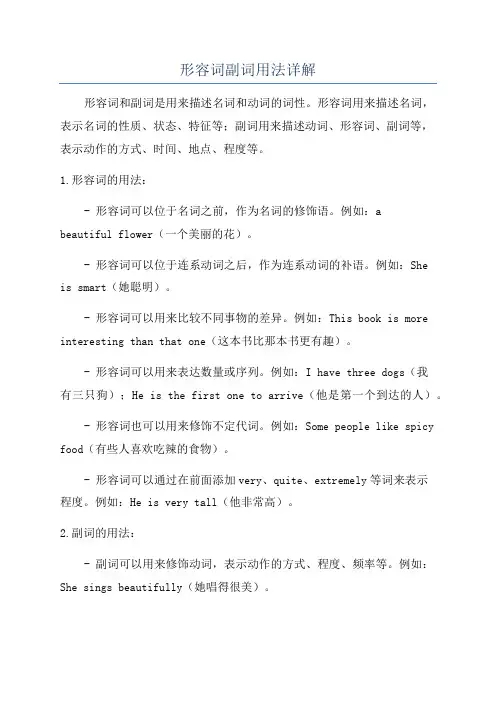
形容词副词用法详解形容词和副词是用来描述名词和动词的词性。
形容词用来描述名词,表示名词的性质、状态、特征等;副词用来描述动词、形容词、副词等,表示动作的方式、时间、地点、程度等。
1.形容词的用法:- 形容词可以位于名词之前,作为名词的修饰语。
例如:abeautiful flower(一个美丽的花)。
- 形容词可以位于连系动词之后,作为连系动词的补语。
例如:Sheis smart(她聪明)。
- 形容词可以用来比较不同事物的差异。
例如:This book is more interesting than that one(这本书比那本书更有趣)。
- 形容词可以用来表达数量或序列。
例如:I have three dogs(我有三只狗);He is the first one to arrive(他是第一个到达的人)。
- 形容词也可以用来修饰不定代词。
例如:Some people like spicy food(有些人喜欢吃辣的食物)。
- 形容词可以通过在前面添加very、quite、extremely等词来表示程度。
例如:He is very tall(他非常高)。
2.副词的用法:- 副词可以用来修饰动词,表示动作的方式、程度、频率等。
例如:She sings beautifully(她唱得很美)。
- 副词可以用来修饰形容词或其他副词,表示程度或程度的变化。
例如:He is extremely smart(他非常聪明)。
- 副词可以用来修饰整个句子或句子的一部分,表示说话者的态度、观点等。
例如:Frankly speaking, I don't care(坦率地说,我不在乎)。
- 副词可以用来表示时间、地点、方向等。
例如:She arrived late (她到达晚了);He went home yesterday(他昨天回家了)。
需要注意的是,有些形容词也可以作为副词使用。
这些形容词一般没有变化。
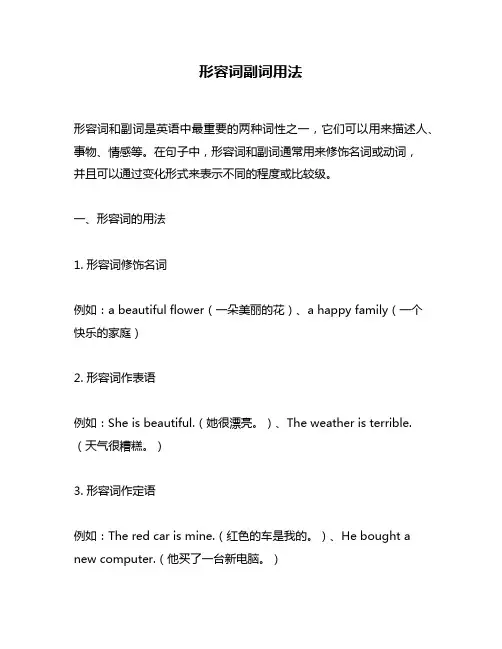
形容词副词用法形容词和副词是英语中最重要的两种词性之一,它们可以用来描述人、事物、情感等。
在句子中,形容词和副词通常用来修饰名词或动词,并且可以通过变化形式来表示不同的程度或比较级。
一、形容词的用法1. 形容词修饰名词例如:a beautiful flower(一朵美丽的花)、a happy family(一个快乐的家庭)2. 形容词作表语例如:She is beautiful.(她很漂亮。
)、The weather is terrible.(天气很糟糕。
)3. 形容词作定语例如:The red car is mine.(红色的车是我的。
)、He bought a new computer.(他买了一台新电脑。
)4. 形容词作宾语补足语例如:I found the book interesting.(我觉得这本书有趣。
)、She made me happy.(她让我感到快乐。
)5. 形容词构成比较级和最高级比较级表示两者之间的比较,最高级表示三者或以上之间的比较。
例如:She is taller than her sister.(她比她妹妹高。
)、This is the best restaurant in town.(这是城里最好的餐厅。
)二、副词的用法1. 副词修饰动词例如:He speaks English fluently.(他英语说得很流利。
)、She runs quickly.(她跑得很快。
)2. 副词修饰形容词或副词例如:She is extremely beautiful.(她非常漂亮。
)、He singsvery well.(他唱得非常好。
)3. 副词作状语例如:I will go to bed early tonight.(我今晚会早点睡觉。
)、She always eats breakfast before work.(她总是在上班前吃早餐。
)4. 副词构成比较级和最高级同形容词一样,副词也可以构成比较级和最高级。
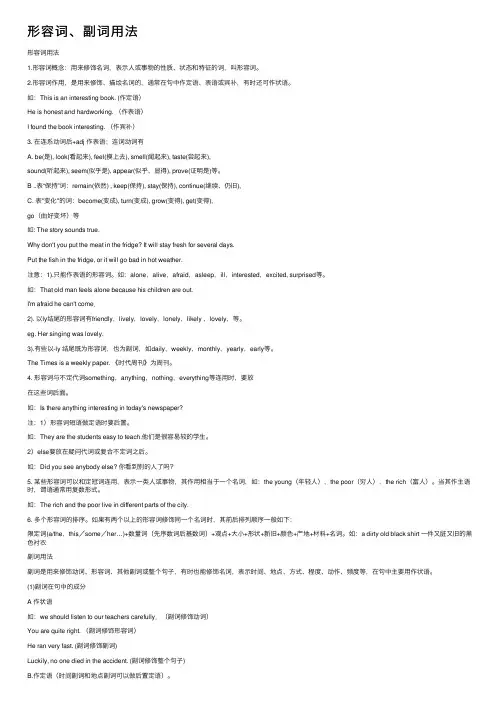
形容词、副词⽤法形容词⽤法1.形容词概念:⽤来修饰名词,表⽰⼈或事物的性质、状态和特征的词,叫形容词。
2.形容词作⽤,是⽤来修饰、描绘名词的,通常在句中作定语、表语或宾补,有时还可作状语。
如:This is an interesting book. (作定语)He is honest and hardworking. (作表语)I found the book interesting. (作宾补)3. 在连系动词后+adj 作表语;连词动词有A. be(是), look(看起来), feel(摸上去), smell(闻起来), taste(尝起来),sound(听起来), seem(似乎是), appear(似乎、显得), prove(证明是)等。
B ..表“保持”词:remain(依然) , keep(保持), stay(保持), continue(继续、仍旧),C. 表"变化"的词:become(变成), turn(变成), grow(变得), get(变得),go(由好变坏)等如: The story sounds true.Why don't you put the meat in the fridge? It will stay fresh for several days.Put the fish in the fridge, or it will go bad in hot weather.注意:1).只能作表语的形容词。
如:alone,alive,afraid,asleep,ill,interested,excited, surprised等。
如:That old man feels alone because his children are out.I'm afraid he can't come.2). 以ly结尾的形容词有friendly,lively,lovely,lonely,likely ,lovely,等。
副词和形容词一、形容词的用法1.形容词修饰名词,并且放在名词的前面,这时形容词在句子中作定语例如: a beautiful lady、a tall man、a big houseA beautiful lady is standing in front of a tall man。
2.形容词放在be动词的后面,这时形容词在句子中作表语/主语补足语。
例如:The lady is tall。
(tall在句子中作表语,说明lady是怎么样的)The beautiful lady is tall。
(beautiful在句子中作定语,tall作表语)The beautiful lady is tall and slim。
3.形容词放在连系动词(become成为、seem看起来、taste尝起来、look看起来、smell闻起来、feel摸起来/感觉、turn变成,等等)后面,在句子中作表语/主语补足语。
例如:The leaf (叶子) turned yellow.树叶变黄了.She looks beautiful./ He looks handsome. 她看起来漂亮./他看来帅气.The food taste good. 这些食物好吃。
The sweater feels soft. (柔软的;舒服的)He becomes careful. (小心的) 他变得小心了.The flower smells very good. 花闻起来很香。
Everything seems good。
一切看起来都好。
二、副词的用法1.副词修饰动词,并且通常放在实义动词后面,这是副词在句子中作方式状语。
例如:The man runs fast。
(fast修饰runs这个动作)She jumps high。
(high修饰jump这个动作)He finished his homework quickly。
(quickly修饰finished这个动作)2.副词修饰形容词,并且通常放在形容词的前面例如:He becomes very handsome。
形容词与副词的用法一、形容词的用法。
1、作定语,放在名词的前方。
比如: a big room2、作表语,放在连系动词的后边,组成系表构造。
比如:She feels warm.常有的连系动词有:①be“是”比如: It is big.②feel“感觉,摸起来” 比如: Lily feels happy.③look“看起来”比如: The old man looks tired.④get“变得..”比如: The weather gets hot.⑤become“变得..”比如: The story becomes true.⑥turn“变得(用于颜色) ..” 比如: When spring comes, leaves turngreen.⑦sound “听起来 ..”比如 : The song sounds beautiful.⑧taste “尝起来 .”比如 : The cookies taste nice.⑨smell “闻起来 ..”比如 : The food smells good.二、副词的用法。
1、修饰行为动词。
比如:Tom runs quickly.2、修饰形容词。
比如:Lily looks quite excited.3、修饰其余副词。
比如:She studies very hard.三、好多形容词能够经过加ly 组成副词 .1、直接加 ly ,比如: slow----slowly2、辅音字母加结尾的,改y 为加 i ,比如: happy----happily四、一些词自己既是形容词,也是副词。
比如:early( 早 ), late( 迟 ), high( 高 ), fast( 快 ), far( 远 ).形容词与副词比较等级的组成:形容词与副词往常有三个等级: 即原级 , 比较级 , 最高等 . 它们的变化以下:一、规则变化:1、一般状况下加 ----er, est. 如 :small---smaller — smallest fast— faster--fastest2、以不发音的 e 结尾的,加—r, ---st.如:late— later — latest large — larger---largest3、以辅音字母 +y 结尾的 , 把 y 改为 i 加— er, ---est.happy---happier—happiest early —earlier — earliest14、以重读闭音节结尾且末端只有一个辅音字母的,双写末端辅音字母再加—er,--est.big — bigger — biggest hot — hotter —hottest fat —fatter — fattestthin — thinner —thinnest5、部分双音节和所有多音节形容词与副词在前方加more, most.形容词加 ly 组成的副词也是在前方加more,most.careful---more careful---most carefulwidely---more widely---most widelyquickly---more quickly—most quicklypopular — more popular---most popular二、不规则变化:原级比较级最高等good, well 好的better bestbad, badly, ill 坏的,糟糕worse worst的,差的many, much 多more mostlittle 少less leastfar 远farther farthest形容词与副词比较等级的用法:1、非常较对象时,用原级。
英语中形容词和副词的用法一、形容词形容词主要用来说明或修饰名词或代词,增加或补充其含义,从而限制或缩小其适用的范围。
表示人或事物的性质、状态和特征。
形容词可在句中充当定语修饰名词、代词,也可作表语表示主语的状态、特征,也可作补语、状语。
作定语:He is a very good swimmer.作表语:He looks very healthy.作宾语补足语:The rain made the ground wet.作主语补足语:She was considered smart.作主语或宾语:The old are respected here and there.The new replaces the old.作状语:Tired and hot, we had to stop to have a break.二、副词副词主要修饰动词、形容词或其他副词,有时也可用来修饰全句。
说明时间、地点、方式、程度等概念。
作状语:It's raining heavily.修饰形容词:It's rather a difficult job.修饰介词短语:The arrow hit the apple right in the middle.修饰从句:This is exactly what she said.修饰名词、代词及数词:Life here is full of joy.She is going to extend her stay there for about two weeks. Nearly everybody came to party.作表语:The class is over.作介词宾语:Who is calling me from downstairs?作定语:Are you content with the life here?作补语:We were shown by the young man.。
形容词与副词的使用技巧形容词和副词是英语中最基本的词类之一,它们用于描述人、事、物的性质、状态、方式等。
正确地使用形容词和副词,能够丰富文章的表达,使语言更加精准生动。
本文将介绍一些使用形容词和副词的技巧,希望能对提升写作能力有所帮助。
一、形容词的使用技巧1. 形容词的顺序:在描述一个名词时,形容词通常按照以下顺序排列:数量、大小、形状、颜色、国籍、材料等。
例如,“She has a beautiful small round red British wooden box.”(她有一个美丽的小的圆形红色英式木盒子。
)2. 形容词的程度修饰:形容词可以使用副词来修饰,表示程度。
常见的副词有very、quite、rather等。
例如,“He is very tall.”(他身材很高。
)3. 形容词的比较级和最高级:形容词可以有比较级和最高级,用于比较不同事物之间的性质。
常见的构成比较级的方式是在形容词后面加上-er,最高级则加上-est。
例如,“This book is more interesting thanthe previous one.”(这本书比之前那本更有趣。
)4. 形容词充当名词:有时,形容词可以直接充当名词使用,表示一类人或事物。
例如,“The poor need our help.”(穷人需要我们的帮助。
)二、副词的使用技巧1. 副词的基本用法:副词用于修饰动词、形容词或者其他副词,使句子更加明确和具体。
例如,“He runs quickly.”(他跑得很快。
)2. 副词的位置:一般情况下,副词放在动词之后,形容词之前。
例如,“She speaks English fluently.”(她流利地说英语。
)3. 副词的程度修饰:和形容词一样,副词也可以表示程度。
常见的副词有very、quite、rather等。
例如,“She is very intelligent.”(她非常聪明。
语法知识形容词与副词语法知识:形容词与副词形容词和副词是英语语法中常用的两类词性,它们在句子中起着修饰名词或动词的作用。
形容词主要用于修饰名词,描述名词的特征和性质,而副词主要用于修饰动词、形容词或其他副词,描述它们的程度、方式、时间等。
一、形容词形容词是用来描述名词的词性,它可以给出名词的属性、特征或状态。
在句子中,形容词通常位于名词之前,用来修饰名词。
1. 形容词的用法形容词可以用来表示名词的颜色、形状、大小、品质、国籍等特征。
例如:- a beautiful flower(一朵美丽的花)- a big house(一座大房子)- a red apple(一个红苹果)2. 形容词的比较级和最高级形容词可以通过在词尾加上-er来表示比较级,加上-est来表示最高级。
此外,有些形容词的比较级和最高级是不规则的,需要记忆。
例如:- tall(高)- taller(更高)- tallest(最高)- good(好)- better(更好)- best(最好)3. 形容词的位置形容词通常放在名词前面,但有时也可以放在名词后面。
例如:- a beautiful girl(一个漂亮的女孩)- a girl beautiful(一个漂亮的女孩)二、副词副词是一类用来修饰动词、形容词或其他副词的词性。
它可以表示时间、地点、方式、程度等含义。
1. 副词的用法副词可以用来修饰动词,表示动作发生的方式、频率、时间等。
例如:- He speaks slowly.(他说话慢慢地)- She always arrives on time.(她总是准时到达)副词还可用来修饰形容词,表示程度或程度的变化。
例如:- The weather is very hot today.(今天天气非常热)- She is quite tall.(她很高)2. 副词的比较级和最高级副词的比较级和最高级形式通常在词尾加上-er和-est,但也有一些不规则变化的副词。
形容词和副词的用法一、形容词 用来修饰名词,表示人或事物的性质、状态和特征的词,叫形容词。
形容词的作用,见下表:作用例句定语You can see a lot of beautiful flowers in the garden.表语Your coat is too small.宾语补足语The old woman keeps everything clean and tidy. 形容词用来修饰something, anything, nothing, everything等不定代词,要放在这些词的后面。
例如: You'd better tell us something interesting. The police found nothing strange in the room. 形容词名词化:有些形容词前加定冠词后变成名词,表示一类人,谓语常用复数。
这类词有:rich / poor; good / bad ; young / old ; healthy / ill ; living / dead ; black / white (表示人种等)。
例如: The young should take good care of the old. 年轻人应该好好照顾老人。
The rich never help the poor in this country. 在这个国家,富人从来不帮助穷人。
表示数量的词组。
如: One day, a young man, twenty-five years old, came to visit the professor. 有一天,一位25岁的年轻人来拜访这位教授。
I live in a building about fifty meters high. 我住在一做大约50米高的大楼里。
else要放在疑问代词之后。
如: Did you see anybody else? 你看到别的人了吗? 二、副词 英语中副词的位置和汉语不尽相同,它的位置比较灵活。
形容词和副词的用法作用:1. 形容词:(1)形容词在句中常修饰名词和代词。
A good boy. Someth ing important _________ (2)形容词在句中作定语、表语、宾语补足语。
Our country is a beautiful country.( 作定语)The meal is delicious.(作表语)We keep our classroom clean and tidy. ( _____ 作宾语补足语 ) 2. 副词:(1) 副词在句中修饰动词、副词、形容词、全句( Luckily )。
She speaks English well.Luckily, I passed the exam.(2) 副词在句中可作状语、表语、和定语。
He studies very hard. _( 作状语)When will you be back. _______ (作表语)very , too, so, really, quite, pretty—、位置1.形容词:通常要放在所修饰的名词之前, 但要放在不定代词之后。
2. 副词:1 )多数副词作状语时放在行为动词之后。
如果动词带宾语,则放在宾语之后。
Mr. Smith works very hard. She speaks En glish well. 2) 频度副词作状语时,通常放在行为动词之前,情态动词、 He usually gets up early. I am n ever late for school. 3) 程度副词一般放在所修饰的名词前面。
He runs very fast.形容词和副词的比较级和最高级。
大多数形容词和副词有三个等级:原级、比较级、最高级。
原级指形容词和副词的原形;比较级用来表示“较……”或“更……一些”;最高级则表示“最 一、形容词和副词的原级:1. 表示两者(A 与B )在某一方面相同时用句型:A + 谓语+ as + 形容词或副词的原形 + as+ B. eg: ① Tom 禾口 Sam 一样高。
Tom is as tall asSam.常用来修饰原级的词有: (something 、anything …) be 动词和助动词之后。
② Tom 和 Sam 跑得一样快。
Tom runs as fast as Sam. En glish is as importa nt as math.A 不如B 时用句型: 形容词或副词的原形 + as+ B. Tom is not as / so tall as Sam.Lucy doesn ' t study as / so well as Lily. 二、形容词和副词的比较级:形容词和副词的比较级表示两个事物在进行比较时, 一者比另一者较/更……。
常用句型:A + 谓语+形容词或副词的比较级+ than + B.eg: ① Tom 比 Sam 高。
Tom is taller than Sam.② Tom 比 Sam 跑得快 Tom runs faster than Sam. 1、形容词和副词的比较级的规则变化: ① 一般直接在词尾加 er 或est tall light② 以字母e 结尾的直接加r 或st fine nice③ 以辅音字母加y 结尾的形容词,要变 y 为i 再加er 或est busy heavy④ 以重读闭音节结尾且末尾只有一个辅音字母的 形容词,要双写末尾的辅音字母再加 er 或estbig hot⑤ 多音节词或部分双音节词的比较级和最高级在其前面加 more 或most 。
in teresti ng — more in terest ing — mosti nteresti ng In teresti ng — more in terest ing — mosti nteresti ng In teresti ng — more in terest ing — mosti nteresti ng2、不规则形容词的比较级最高级练习:列形容词的比较级和最高级(1) ill/bad /badly(2) busy③英语和数学一样重要。
2. 两者(A 与B )在某一方面A + 谓语 + not as / so + eg: 1 ) . Tom 不如 Sam 高。
2 ) . Lucy 不如Lily 学习好。
(3) big (4)rude(5) hot (6)easy(7) little (8)fast(9) hard (10)many /much (11) happy (12)far(13) careful (14)good/well (15) difficult (16) small(17) quiet(18) old3、形容词比较级的用法 :(1) 两者(A 与B )进行比较,“ A 比B 较/更……”。
A + 谓语 + 形容词或副词的比较级 + than + B.eg: 1). 英语比数学重要。
English is more important than math.2). Lucy 比 Lily 学习好。
Lucy studies better than Lily. (2) 两者(A 与B )进行比较,“ A 比B 大/长/高……” A+ 谓语 +数量词 +形容词或副词的比较级 +than+ B eg: Tom 比Sam 大两岁。
Tom is two years older than Sam.(3)两者(A 与B )进行比较,“哪一个更 /较……” Which/Who 谓语 + 比较级 , A or B ? eg:数学和英语哪一科较简单? Which is easier, math or English? Tom 和 Sam 谁跑得更快? Who runs faster, Tom or Sam?(4)两者(A 与B )进行比较,“其中 A 是两者中较…”A+ 谓语 + the + 比较级 + of the two. eg :Tom is the taller of the two boys.汤姆是这两个男孩中最高的5)比较级 + and + 比较级, 表示 “越来越…” eg: Now it is hotter and hotter.The more you eat, the fatter you will become. 7)用形容词的比较级来表达最高级的概念:A+ 谓语 +比较级 +than any (other ) + 可数名词单数 +范围。
“A 是……中最……的”或“ A 比(其他)任何……都••… 注:当 A 在范围内比较时,必须加 other; 当 A 不在范围内比较时,去掉 other. eg :上海比中国其他的任何一个城市都大 Shanghai is bigger than any other city in China.上海比日本的任何一个城市都大Shanghai is bigger than any city in Japan. (8)修饰比较级的词much ( …的多)、far (…的多)、a lot (…的多)、even (更…)、still (仍然)、 any ( 任何 )a bit ( …一点儿 ) a little ( …一点儿 ) eg: ① This city is much more beautiful than that one. 这座城市比那座城市漂亮的多。
② Today is even hotter than yesterday.( 9 )修饰形容词原级的词: v ery 、 rather 、 pretty 、 so 、 quite 、 tooHe is too tired to walk on. 他太累了以至于不能再继续走了。
三、形容词、副词的最高级形容词和副词的最高级常用来表示三者或三者以上人或物的比较。
形容词最高级前现在越来越热。
more and more beautiful6) The + 比较级…, the + eg :越多越好。
The more , the better.越来越漂亮比较级…“越•…就越…”你吃的越多,你就越必须加定冠词the,而副词的最高级前可以不加定冠词 the 。
但是当形容词的最高级前已经有了作定语用的形容词性的物主代词或名词所有格时,不在加 the 。
1主语+谓语+the +形容词或副词的最高级+of/in 短语。
表示“主语是……中最……的”。
① My mother is the busiest in my family.我妈妈是家中最忙的。
② I jump (the) farthest in my class.我是我们班跳得最远的。
2、 one of the+ 形容词最高级+cn.复数 “最 ......... 之一”。
Beiji ng is one of the largest cities in China. 北京是中国最大城市之一。
3、 the +序数词+形容词最高级+名词表示“第几大/长/高 ..... ” The Yellow Riverthe sec ond Ion gest river in China .黄河是中国第二长河。
4、 Which/Who +谓语+ the +形容词或副词最高级,A ,B or C ?表示“三者中哪一个更、最 ... ”Which is the biggest , the moon, the earth or the sun ? 月球、地球和太阳哪一个更大? 四、比较级与最高级的互换Jim is taller than any other boy in our class.( 吉姆比我们 班上任何一个男孩都高) =Jim is taller than the other boys in our class.( 在我们班上吉姆其它的男孩高)=Jim is the tallest in our class. (吉姆是我们班最高的)I. 用形容词的正确形式填空1. Which do you like ________ (well), apples, pears or banan as?2. I think this story is _________________ (in teresti ng) tha n that one.3. I n the morni ng he is _______ (early). His father is _________ (early) tha n he.His mother is the ___________ (early) of the three.4. The Yellow River is the sec ond ___________ (long) river in Chi na.5. This road is __________ ( wide )than the other one.6. I feel math is ______________ (difficult) than Chi nese.7. My sister is _______ tha n I. ( young )8. In summer it is _______ in Wuha n tha n in Beiji ng. ( hot )) 1.Yang won the women s500 metersin thesports meeti ng.She didof all.A. bestB. betterC. wellD. good( ) 2. -It 'sso coldtoday.-Yes,it ' scoldertha nit was yesterday.A. someB. moreCveryD. much( )3. Tom does his homeworkLucy.A. as carefully asB. so carefulasC.as careful (asD. socarefully as(4. You must driven ext time, ortheremay be another丿 accident.A. reallyB. quiteC. veryD. a little( )6. I got to the station ___ than Jim.A. early 20 minutesB. earlier 20 minutesC. 20 minut es earlyD. 20 minutes earlier( )7. Now China has joined WTO, so I think English is __________________________________useful thanmuch before.A. moreD. manyC.() 8. Jane's brother didn 'td in his class.A. harderC. hardestD. hardly ()9. I was ill(的yesterday. But now I feel much ol tomorrow.A. worseB. mostwork so _________ as the others diB. hard病 _ . I think I can go to schoB. badA. more carefullyB. carefullyC. c arefulD. more careful( ) 5. This question is more difficult than that one.C. betterD. well。